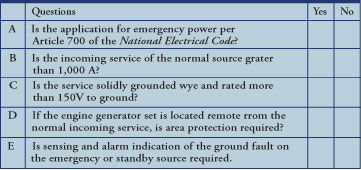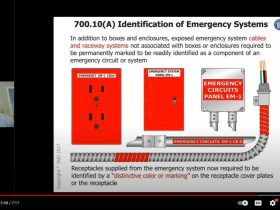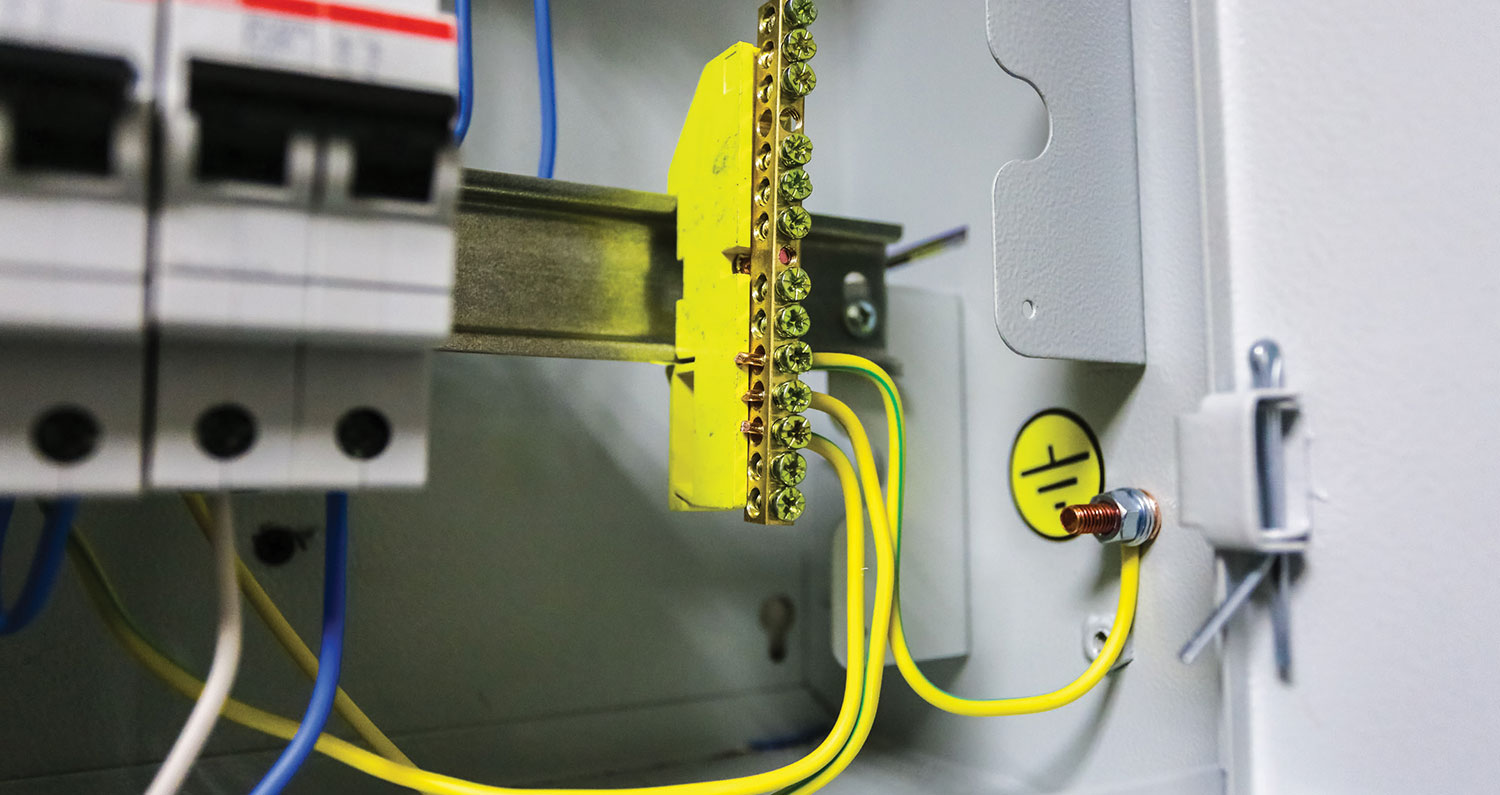When engine generator sets are used as an alternate source of power (i.e., emergency or standby power), it is essential that they be properly grounded and that associated transfer switches be properly selected. This is necessary to assure safety of personnel, protection of equipment, reliable ground-fault sensing and continuity of power to electrical loads.
Unique circumstances relating to emergency power systems require special grounding considerations. For example, in large building complexes, consideration should be given to possible power disruption within the facility and the need for area protection. Due consideration should be given to effects of multiple ground connections, need for ground-fault protection, selection of transfer switches and conformance to current code requirements. Though this article applies to most emergency and standby systems, it does not cover transfer switching in medium voltage systems or UPS with a solid-state inverter as an alternate source.
Electrical power systems require two types of grounding, namely system grounding and equipment grounding. As will be shown, each has its own functions.
System Grounding

Photo 1. Bonding jumper to generator frame
System grounding pertains to the nature and location of an intentional interconnection between the electric system conductors and grounding electrode systems which provide an effective connection to ground (earth). In other words, it relates to how and where the grounded conductor is connected to earth.
Purpose of System Grounding:According to Section 250.4 of the National Electrical Code, system and circuit conductors are grounded to limit voltages due to lightning, line surges, or unintentional contact with higher voltage lines, and to stabilize the voltage to ground during normal operation. Systems rated 600 volts or less are solidly grounded to facilitate overcurrent device operation in case of ground faults.
Power Systems:For maximum reliability, transfer switching is often located close to the point of power utilization (load). In most commercial and many industrial installations, critical loads are rated 600 volts or less. The following emergency power systems are commonly used to supply phase-to-neutral loads and should be solidly grounded:
240/120 volt, single-phase, three-wire system
480/240 volt, single-phase, three-wire system
208Y/120 volt, three-phase, four-wire wye system
480Y/277 volt, three-phase, four-wire wye system
600/347 volt, three-phase, four-wire wye system
240/120 volt, three-phase, four-wire delta system
Solidly Grounded Systems:To facilitate overcurrent device operation the equipment grounding conductors for solidly grounded systems are required to be bonded to the system grounded conductor at the service equipment and at the source of a separately derived system (standby or emergency power). This bond completes the ground-fault current return path from the equipment grounding conductors to the system grounded conductor. System grounding conductors and grounding electrodes are not intended to conduct the ground-fault current that is due to a ground-fault in equipment, raceways, and other enclosures. In solidly grounded systems, the ground-fault current flows through the equipment grounding path.
Solidly grounded systems exercise the greatest control of overvoltages but result in the highest magnitudes of ground-fault current. However, the inherent regulation of alternate source generators generally limits the available fault current. If line-to-neutral loads must be served, high resistance grounding of the generator neutral is not permitted because the neutral should never be used as a circuit conductor in systems that are grounded through a high resistance.
Equipment Grounding
It is important that all exposed metallic parts of electrical equipment be bonded to a grounding electrode. This includes metallic parts such as engine generator frames, metallic electrical conduit and raceway enclosures, cable trays, cable shields and metallic racks and ladders in vaults.
Purpose of Equipment Grounding:The purpose of equipment grounding is to assure the following functions:
1. To maintain a low potential difference between nearby metallic members and thereby protect people in the area from electric shock.
2. To facilitate the operation of circuit protective devices by providing low impedance conducting paths for ground-fault currents.
3. To provide an effective electrical conductor system over which ground-fault currents can flow without creating a fire or explosive hazard.
Equipment Grounding Paths:Only by providing adequate equipment grounding paths for metallic enclosures, frame of an engine generator set, etc., in a manner which assures adequate current-carrying capability and an adequately low value of ground-fault circuit impedance, can both electric-shock hazard and fire hazard be avoided. Technical investigations have pointed out that it is important to have good electric junctions between sections of conduit or metal raceways that are used as equipment grounding paths, and to assure adequate cross-sectional area and conductivity of these grounding paths. Where systems are solidly grounded, equipment grounding conductors are bonded to the system grounded conductor and the grounding electrode conductor at the service equipment and at the source of a separately derived system in accordance with the requirements of Sections 250.30, 250.64 and 250.130 of the NEC.
The same network of equipment grounding paths is required for systems that are solidly grounded, high-resistance grounded, or ungrounded. The equipment grounding paths in high-resistance grounded or ungrounded systems provide shock protection and a conducting path for phase-to-phase fault current if two ground faults occur simultaneously on different phase conductors.
Engine Generator Frame:The engine generator frame, automatic transfer switch enclosure, conduits and other exposed components of an emergency power system should be permanently bonded together and connected to the grounded conductor of the service equipment providing normal power and/or the grounded conductor of the engine generator set. By means of grounding electrode conductors, these grounded conductors are connected to grounding electrodes at their respective locations.
TheNational Electrical Codepermits the grounding electrode to be a metal underground water pipe, which may be part of a municipal water piping system or a well on the premises. However, buried portions of a water pipe system less than 10 feet in length or that may include plastic or cement materials should not be used. For small emergency power systems where the ground currents are of relatively low magnitude, existing buried water pipe systems are usually preferred as electrodes because they are economical in first cost. Nevertheless, before reliance can be placed on any existing electrodes, it is essential that their resistance to earth be measured to insure that some unforeseen discontinuity has not seriously affected their suitability. Also, care should be exercised to ensure that all parts which might become disconnected are effectively bonded with flexible bonding jumpers.
Transfer Switching
An engine generator set may or may not be considered as part of a “separately derived system” as defined by Article 100 of theNational Electrical Code:
Separately Derived Systems.A premises wiring system whose power is derived from a battery, a solar photovoltaic system, or from a generator, transformer, or converter windings, and that has no direct electrical connection, including a solidly connected grounded circuit conductor, to supply conductors originating in another system.
An engine generator set can only be considered to be a part of a separately derived system with its neutral terminal separately grounded when the associated transfer switch provides switching of the neutral conductor. In order to comply with the National Electrical Code definition for separately derived systems, grounding of the engine generator’s neutral terminal could therefore only be done by one of two methods:
1. Permanently ground the neutral terminal of the engine generator at only the grounding electrode of the incoming service for the normal utility source. There would be no switching of the neutral conductor, and the emergency or standby source would not therefore be considered a separately derived system. It later became apparent that this method did not resolve all ground-fault sensing problems.
2. Permanently ground the neutral terminal of the engine generator at its location. This would require transfer switching of the neutral conductor, and the emergency source would be defined as a separately derived system.
Providing reliable ground-fault protection in electrical systems having alternate emergency or standby power can be difficult unless adequate equipment is selected and properly coordinated. Multiple neutral-to-ground connections may prevent adequate sensing of ground-fault currents and may also cause nuisance tripping of circuit breakers. To assure proper ground-fault protection, understanding code requirements can be helpful, including Sections 230.95, 250.30 and 445.3 of theNEC.
There are three approaches to consider in meeting the current requirements of the Code. For a three-phase 4-wire grounded system, they include (1) using a 3-pole transfer switch with the engine generator set considered as a non-separately derived source, (2) using a 4-pole transfer switch with the engine generator set considered as separately derived source, and (3) using a 3-pole transfer switch with overlapping neutral contacts with the engine generator set considered as a separately derived source. However, just meeting the minimal requirements of the Code, does not necessarily provide the degree of reliability needed for a good emergency power system. The system designer should consider the following: An engine generator set is often remotely located from the grounded utility service entrance and the ground potentials of the two locations may not be the same.

Figure 1. No area protection with ungrounded engine generator set providing power to the load
Good engineering practice requires the automatic transfer switch to be located as close to the load as possible to provide maximum protection against power failure due to cable or equipment failures within the facility (area protection). Thus, the distance of cable between incoming service and the transfer switch and then to the engine generator set may be substantial. Consider what would happen if a cable failure occurred, as in figure 1, with the engine generator not grounded to its own grounding electrode. The load would be automatically transferred to an ungrounded emergency power system. This, in turn, could jeopardize emergency service continuity and possible lead to additional failures. Concurrent failure of equipment or cable failure (break-down between line and equipment ground) after transfer to emergency may not be detected. Thus the generator frame may approach line potential, causing a substantial voltage difference between the generator frame and the grounded conductor (neutral).
Some local codes require ground-fault protection while the engine generator is operating. This may present a sensing problem if the neutral conductor of the generator is not connected to a grounding electrode at the generator site and proper isolation of neutrals is not provided. Furthermore, some local and state codes (Pennsylvania and Massachusetts) require area protection, which may create additional problems unless the neutral conductor of the generator is isolated and grounded at the generator location.
When the transfer switch is in the emergency position, other problems may occur if the engine generator set is not properly grounded. For example, a ground-fault condition could cause nuisance tripping of a normal source ground-fault circuit breaker even though load current is not flowing through the breaker. This would prevent automatic retransfer to the normal source and isolation of the fault condition. This would not be in accord with Section 230.95(C), FPN No. 3 of the National Electrical Code which states, “Where ground-fault protection is provided for the service disconnecting means and interconnection is made with another supply system by a transfer device, means or devices may be needed to assure proper ground-fault sensing by the ground-fault protection equipment.” Furthermore, both the normal neutral conductor and the emergency neutral conductor would be simultaneously vulnerable to the same ground-fault current. Thus a single fault could jeopardize power to critical loads even though both utility and emergency power are available. Such a condition may be in violation of codes requiring independent wiring and separate emergency feeders.
Three-Pole Transfer Switching:Using three-pole transfer switches is the least expensive

Figure 2. Improper ground-fault sensing
approach and requires less space, and the system is not considered as a “separately derived system.” However, ground-fault currents may trip the normal source breaker when the load is connected to the engine generator set (see diagram in figure 2). Furthermore, use of 3-pole transfer switches does not provide area protection within the facility and this could lead to an ungrounded power system in the event of cable failure (see diagram in figure 1). Finally, with the neutral conductor connected to the incoming normal service, it is difficult to provide ground-fault sensing on the emergency side as required to meet Section 700.7(D) of the National Electrical Code.
Four-Pole Transfer Switching:A better solution is to use a four-pole transfer switch which provides complete isolation of service and generator neutral conductors. This eliminates possible improper ground-fault sensing and nuisance tripping caused by multiple neutral-to-ground connections. When this is done the generator will comply with the current National Electrical Code definition of a separately derived system. With the neutrals thus isolated, ground-fault protection with conventional sensors can be added to the generator output.

Photo 2. Transfer switch showing a switched neutral conductor
Four-pole transfer switches have been satisfactorily applied on applications where the loads are passive and relatively balanced. However, unbalanced loads may cause abnormal voltages for as long as 10 to 15 milliseconds when the neutral conductor is momentarily opened during transfer of the load. Transfer switches are frequently called upon to operate during total load unbalance caused by a single phasing condition. Inductive loads may cause additional high transient voltages in the microsecond range. Furthermore, it should be remembered that the contacts of the fourth switch pole do interrupt neutral currents and are, therefore, subject to arcing and contact erosion. However, contact erosion of the fourth pole can be minimized if the fourth pole is designed to open last (after the three other poles interrupt the load current) and make first contact without bounce. In any event, a good maintenance program must reaffirm at intervals the integrity of the fourth pole as a current-carrying member with sufficiently low impedance.
Both theNational Electrical Codeand Underwriters Laboratories, Inc. recognize the use of four-pole transfer switches for 3-phase, 4-wire systems. In some European countries, including Germany and France, it is mandatory to use 4-pole switching devices.
Overlapping Neutral Contacts:Another method for isolating the normal and emergency source neutrals is for a 3-pole automatic transfer switch to include overlapping neutral transfer contacts. This feature provides the necessary isolation between neutrals and at the same time minimizes abnormal switching voltages. By means of overlapping contacts, the only time the neutrals of the normal and emergency power sources are connected together is during transfer and retransfer. With a solenoid-operated conventional double throw transfer switch, this duration can be less than the operating time of the ground-fault sensor which is usually set anywhere from 6 to 24 cycles (100 to 400 milliseconds).

Figure 3. System with overlapping neutral contacts
Figure 3 shows a typical system utilizing a three-pole transfer switch with overlapping neutral transfer contacts for isolating the neutral conductors. Note that there is no possible flow of fault current through the neutral conductor that would detract from or effectively reduce ground-fault detection. Furthermore, there is no possible flow of unbalanced current through the generator neutral to alter the response level of the ground-fault sensor and possibly cause nuisance breaker tripping. As with four-pole transfer switches, conventional ground-fault sensing can be readily added to the emergency side. As shown in figure 3, ground-fault sensing on the emergency side is often used for actuating an alarm circuit rather than tripping a breaker, such as required per Section 700.7(D) of the National Electrical Code.
With overlapping neutral transfer contacts, the load neutral is always connected to one source of power. In that there is no momentary opening of the neutral conductor when the transfer switch operates, abnormal and transient voltages are kept to a minimum. Another advantage is that there is no erosion of the overlapping contacts due to arcing, thus assuring current-carrying integrity and no increase in impedance of the neutral circuit. It should be noted that a 3-pole transfer switch with overlapping neutral contacts should not be specified as a 4-pole switch, according to Underwriters Laboratories Standard UL-1008 and theNational Electrical Code.
Selecting Transfer Switching Equipment:For three-phase four-wire systems involving one transfer switch and one engine generator set, response to the questions in table 1 serve as a guide in selecting the type of transfer switch needed for a particular application.
If the responses to the first three questions (a, b and c) are all “yes,” it is necessary to use a 4- pole transfer switch or a 3-pole transfer switch with overlapping neutral contacts in order to satisfy the requirements of the 1999 National Electrical Code. If the answer is “no” to any one of these questions, then proceed with questions d and e.
If the response is “yes” to either question d or e, use a 4-pole transfer switch or a 3-pole transfer switch with overlapping neutral contacts in order to satisfy the requirements of the National Electrical Code. If the answers are “no” to both questions, a less expensive 3-pole transfer switch without overlapping neutral contacts can be used. Then the neutral terminal of the generator should be grounded at the incoming service of the normal source.

Table 1. Guide for selecting the type of transfer switch
Although the above questions apply to three-phase four-wire systems, the same approach can be taken for single-phase three-wire systems to determine the transfer switching equipment. However, most single-phase systems are 400 amperes or less, and therefore can be satisfied with 2-pole transfer switches. It should be kept in mind that the above selection approach only applies to applications with one engine generator set and one transfer switch.
Multiple Transfer Switches:Multiple transfer switches, located close to the loads, are often used rather than one transfer switch for the entire load. In such cases, consideration should be given to the possibility of cable or equipment failure between the service equipment and the transfer switches, thus possibly causing an emergency or standby power system to become ungrounded. This is particularly important if a solidly interconnected neutral conductor is grounded at the service equipment only.

Figure 4. Multiple automatic transfer switches with improper ground-fault sensing
Under such conditions, there is a possibility of tripping the ground-fault circuits when no ground fault exists. Figure 4 illustrates a typical system with multiple three-pole transfer switches. When power is supplied from the normal source to the load through a transfer switch, the neutral current will divide between two neutral conductors. Some of the current will return by the normal return path. The remainder of the current will flow to the neutral terminal of the engine generator and through the neutral conductor of the other transfer switch to the normal source. This can cause tripping of either ground-fault circuit breaker even when no ground-fault exists. The problem can be corrected by the use of the three-pole transfer switches with overlapping neutral or four-pole transfer switches.
Multiple Engine-Generator Sets:When multiple engine-generator sets are connected in parallel and serve as a common source of power, each generator neutral is usually connected to a common neutral bus within the paralleling switchgear, which, in turn, is grounded. The associated switchgear containing the neutral bus should be located in the vicinity of the generator sets. A single system-grounding conductor between the neutral bus and ground simplifies the addition of ground-fault sensing equipment.
However, engine-generator sets that are physically separated and used for isolated loads may necessitate additional neutral-to-ground connections. By using multiple four-pole transfer switches or three-pole switches with overlapping neutral contacts, proper isolation and ground-fault sensing can be obtained.
Upgrading Transfer Switching Equipment:Upgrading older transfer switch equipment to present codes and standards can be a real challenge, particularly for larger and more complex industrial and commercial facilities. Awareness that three-pole transfer switches may not always provide complete isolation and proper ground-fault sensing has not been too apparent in the past. With more emergency and standby power systems being updated, the concern regarding safety and product liability should not be treated too lightly. This concern provides another reason for upgraded installations to include adequate grounding and preferably new transfer switches that provide switching of the neutral conductor. Regardless of whether or not ground-fault sensing is required, proper switching of the neutral conductor is good engineering practice because of the system isolation, improved grounding and the extra safety it can provide.
Conclusions
As pointed out in this article, there are a number of factors that should be considered when coordinating transfer switching and grounding of engine generator sets. Simply conforming to minimum code requirements will not necessarily assure the degree of reliability required for such systems. Thorough consideration should be given to protecting against power disruption within the building or facility and providing adequate ground-fault protection. Techniques for both equipment grounding and system grounding should be such as to provide optimum safety and assure maximum continuity of power to essential loads. This includes proper grounding and ground-fault sensing when the transfer switch is in the emergency position as well as the normal position.
As a general rule, in most applications requiring ground-fault sensing, area protection, multiple transfer switches, or multiple engine generator sets, the on-site power should be considered as a separately derived system. In such cases the neutral of the engine-generator set is grounded at its location.
It is not intended for the scope of this paper to cover in detail all aspects of grounding on-site power systems. Those requiring more detailed information may find the following list of references helpful.
References
[1]EGSA On-Site Power Generation: A Reference Book, Fourth Edition, Electrical Generating Systems Association, Coral Springs, FL.
[2]National Electrical Code, NFPA No. 70-2002, National Fire Protection Association, Quincy, MA.
[3] IEEERecommended Practice for Grounding of Industrial and Commercial Power Systems(Green Book), Standard 142-1991, Institute of Electrical and Electronic Engineers, New York, NY.
[4]Standard for Automatic Transfer Switches, UL 1008, Underwriters Laboratories, Melville, NY.
[5]Proper Grounding of On-Site Electrical Power Systems, by R. Castenschiold and G.S. Johnson, IEEE Industry Applications Magazine, March/April 2001, Institute of Electical and Electronic Engineers, New York, NY.
[6] IEEERecommended Practice for Emergency and Standby Power Systems(Orange Book), Standard 446-1995, Institute of Electrical and Electronic Engineers, New York, NY.














Find Us on Socials